Summary
About 5 years ago, I joined the world of high growth venture capital backed startups, where people’s minds revolve around scaling a business. Recently the following question came to my mind: how can a person 10x its impact? A lot of work and continuous (almost exponentially) growth in productivity
Growth Equation
I love to use numbers to think, so I thought about what could be an equation to describe impact and came up with the below.
 Figure 1: Impact = Work Hours x Impact per Hour.
Figure 1: Impact = Work Hours x Impact per Hour.
The first lever to have a big impact is to work long hours, but I thought about my experience in investment banking - is this sustainable over a lifetime? No, but there is a benefit at the beginning of one’s career (~5-10 years) to go along this route, because the more you work, the more you learn and therefore it increases lever #2 - impact per hour (up to a point). I thus considered three scenarios:
- Max Weekly Effort: go really hard for 30 years at 80+ hours per week, stepping down to 60h+.
- Average Weekly Effort: work for 40 years 40+ hours per week.
- High Leverage Effort: go really hard for 5 years and progressively work less.
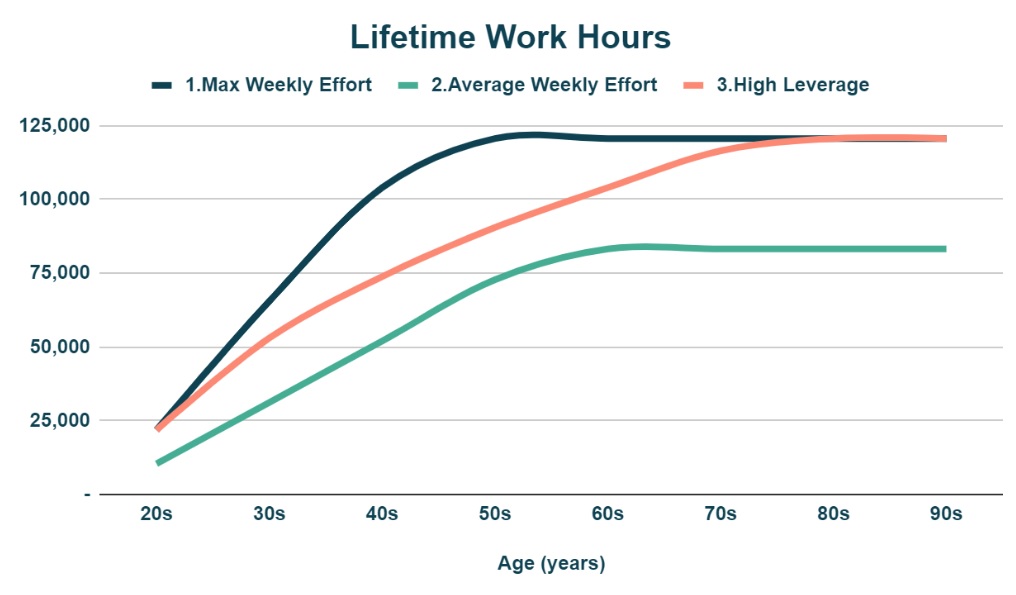 Figure 2: Lifetime Work Hours.
Figure 2: Lifetime Work Hours.
Over a lifetime, for scenario 1 and 3, total work hours is the same (~121,000)
but the first scenario takes a much higher toll physically and mentally on the person.
For scenario #2, total work hours are 30% lower (~83,000).
The second lever to have a big impact is to increase the impact per hour worked.
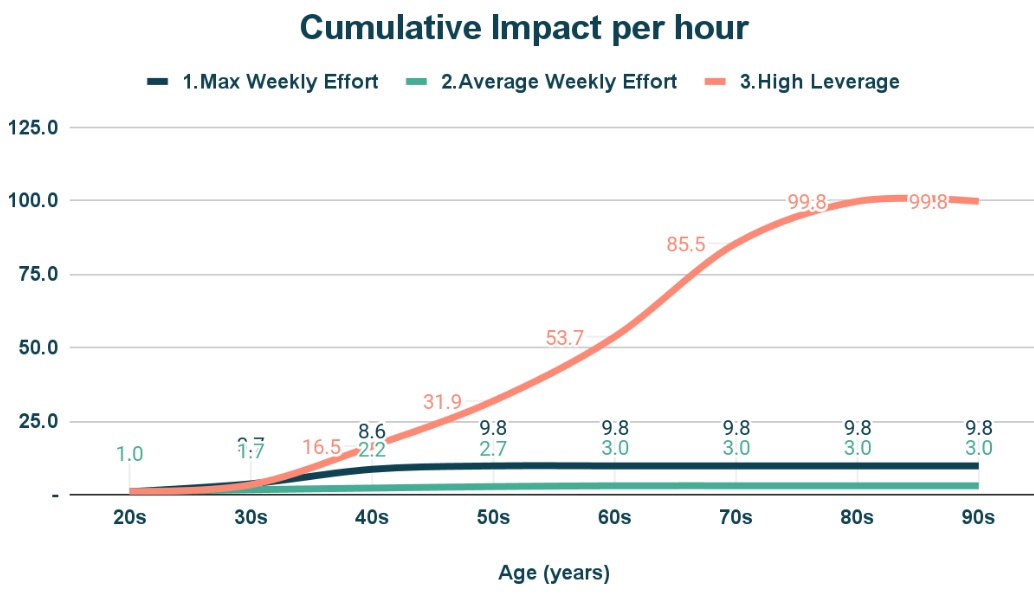 Figure 3: Impact per hour.
Figure 3: Impact per hour.
In scenario #1, the person works very hard for a very long time but somehow it onlys
ends up growing its impact per hour to ~10 vs 3 for scenario #2 - a good improvement
but still it is not 10x better.
In scenario #3 (high leverage) however something “magical” happens. The person is able to continuously
grow (almost exponentially) its impact over a lifetime.
In its mid 40s its impact is 10x vs scenario #2.
In its mid 50s it’s impact is 5x vs scenario #1 and it keeps growing…
 Figure 4: Total Impact.
Figure 4: Total Impact.
So, as I used numbers to think about the 10x route, I concluded that it boils down to:
- Working for a very long time - this is only possible if you find purpose in what you do but at the same time don’t work so much that you burnout along the way.
- Increase the impact of each hour worked - this requires getting better over time and increasing the impact per hour of other people.
The 10x route is thus unfortunately not available to most people. Few people want to
work for a long time. Even fewer are able to massively grow their impact per hour (me included).
The silver lining is that anyone can focus on growing its impact per hour
(even if it is just a bit). The more you grow this lever, the less pressure there is to work long hours.
Lever #1: working for a very long time
Clarity of thinking is of paramount importance in order to do something for a long time. This is built on internal and external factors.
What is really important for you?
Knowing what is important for you is the foundation for working a long time,
therefore it needs to be rock solid. Unfortunately, it takes a long time and
experimentation to figure it out, so it is important to be patient.
The person you are today, is different from the person that you will become in the future,
hence what is really important for you also changes over time.
After several iterations over many years, I came up with three pillars. What are yours?
 Figure 5: Key Pillars (internal).
Figure 5: Key Pillars (internal).
Choose Purpose over Passion
Being passionate about something is a feeling that makes us feel better and
gives us a strong drive to do something for a long time. However, there will be
times when things are difficult and the easy (and likely) thing to do is to move on
to something else.
On the other hand, purpose is about something bigger than yourself
(your child, your family, your country, etc). When things get tough
it is much more likely that you will keep going, because you can’t bear to
think about the impact of giving up.
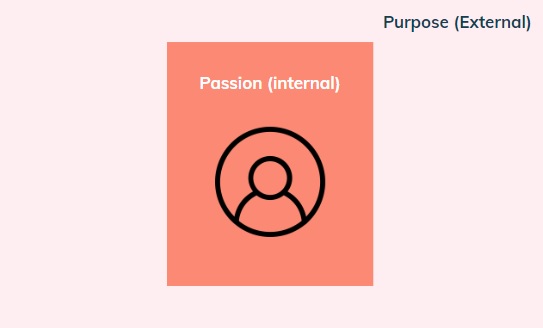 Figure 6: Purpose over Passion.
Figure 6: Purpose over Passion.
Lever #2: Increase impact per hour
This is all about personal growth but there is only so much you can do individually. A step change requires being part of a team and helping others to grow (it is like becoming a gardener).
High Leverage Activities
I really recommend reading the book “High Output Management” by Andrew Grove.
Among several important things mentioned there, the key thing that always stuck in
my mind was the concept of a high leverage activity. How can one hour of a person's
time impact how others work (eg 1h impacts 10 people, 10x leverage).
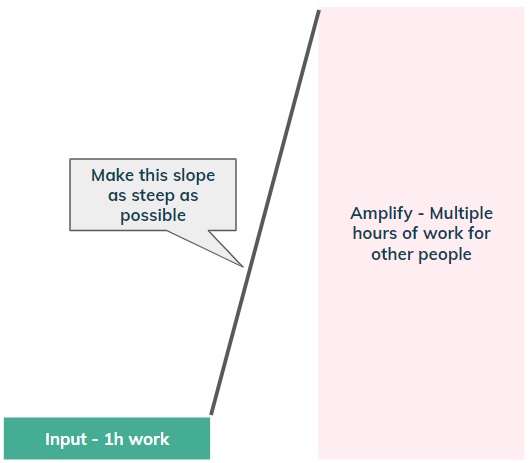 Figure 7: Amplify the impact of your work.
Figure 7: Amplify the impact of your work.
The obvious conclusion is that doing it alone is a low leverage activity. One needs to be part of a team and really care about making others grow their impact per hour. Increasing continuously the leverage of one’s activity is key, in order to grow impact per hour.
Filter out the noise and do what really matters
We live in an increasingly busy world with many different sources of distraction.
It is easy to scatter our focus over several things. I think it is really important
to prioritise doing what really matters to move the needle towards a vision or getting
better at something. The picture below summarises this idea very well.
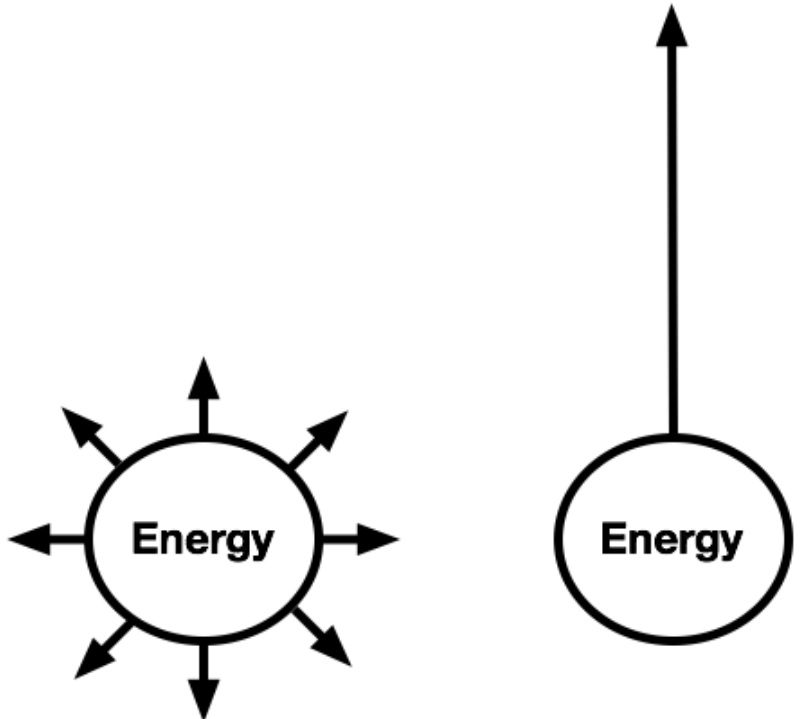 Figure 8: Focus (Source: Essentialism by Greg McKeown).
Figure 8: Focus (Source: Essentialism by Greg McKeown).
Important not urgent
We get to spend our life in one of the four quadrants below.
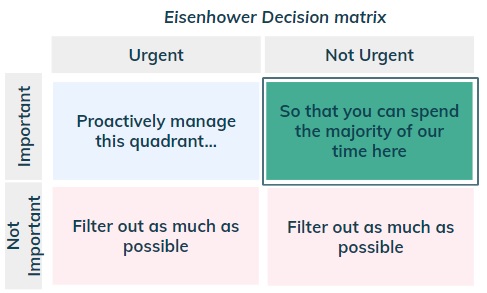 Figure 9: Prioritise Important and Not Urgent.
Figure 9: Prioritise Important and Not Urgent.
Anything that is not important should be avoided/filtered as much as possible. Whenever making decisions it is really important to optimise for the long term, i.e. the not urgent and important quadrant, as this is what enables one to develop the skills required to increase and sustain a high impact per hour. The biggest danger is to keep getting sucked into the urgent and important quadrant - it is essential to proactively manage this and think ahead of time to avoid being stuck here.
Switch focus to the long term
When we are younger, due to the nature of a short life experience,
it is natural for the focus to be on short term things. Progressively,
as one gets more experienced in life and work it is important to progressively
switch focus to the long term.
 Figure 10: Focus on the long term.
Figure 10: Focus on the long term.
A 10x growth in impact will not happen overnight - it will take years to get there. Therefore, it is very important to ensure that any actions or decisions taken today, optimise for the long term even if there is some short pain. It makes no sense to do something today that crystallises a low growth trajectory.
Baby steps
I thus find it helpful to break down a big goal into baby steps each week and then organise my time as per below.
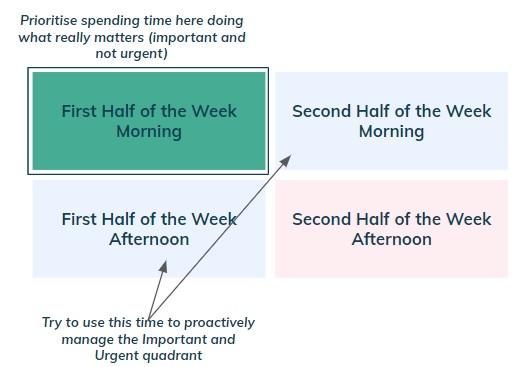 Figure 11: Weekly structure.
Figure 11: Weekly structure.
Whatever is most important for a particular week, I like to focus on getting it done in the morning and in preference in the first half of the week. If you have a very effective week, you would feel comfortable chilling out on a Friday or simply use the time for creative thinking.
I also think it is important to distinguish effective vs efficient:
- Effective = doing the right thing, ideally quickly (what really matters long term)
- Efficient = doing something quickly (potentially the wrong thing)
Broaden perspective
For someone in the beginning of their career, they need to focus their attention on
learning the ropes of their job and therefore it is very hard to have a broader perspective other people’s point of view in other teams.
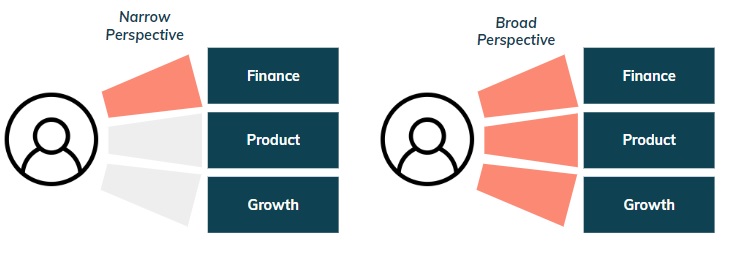 Figure 12: Broaden perspective across different domains.
Figure 12: Broaden perspective across different domains.
As one becomes more proficient in specific domain expertise (e.g. finance),
the next step is to start learning about other domains. This makes a person more
effective at working with others and seeing a problem from different angles, in order
to collectively figure out the optimal solution.
It is necessary to develop a broad perspective and knowledge across different domains.
Get a coach to give you feedback
For some reason that I am not able to explain, I love to do handstands (see below).
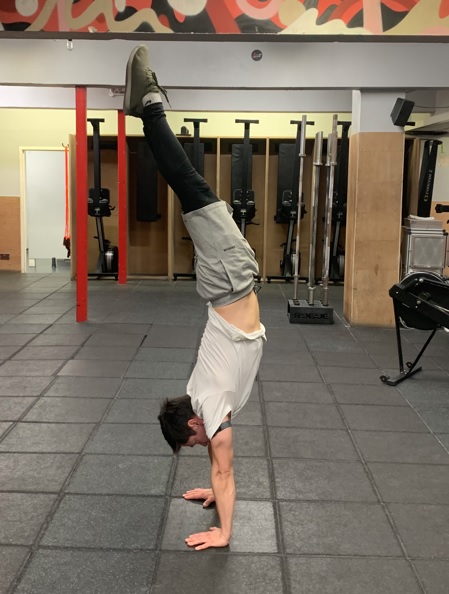 Figure 13: Me doing a handstand in April 2023.
Figure 13: Me doing a handstand in April 2023.
However, it was a long journey to get to this level. I started in 2016 and tried more than 5,000 times to progressively get better. At some point it occurred to me that I was doing something wrong, as I was not improving much. I then decided to use a coach for a few sessions and buy some online courses from experts. What a difference in my growth trajectory - I had several blindspots and needed feedback to improve and overcome obstacles along the way.
About one year ago, I decided it was important to have a career coach to prevent me
from doing the same mistake I did on the handstands. I ended up working with two
coaches with different backgrounds (thank Catherine and Meggy) and both of them were
critical to give me feedback and to help me grow.
When I switched careers from engineering to investment banking in 2008, I was
fortunate to have two people (thank you Andreas and Elias) that gave me valuable
insights and coaching that were fundamental for a successful career change.
In short, it is key to have mentors and career coaches along the way. It is critically important to have someone else's perspective to give you feedback, help you get better over time and identify blindspots.
Master what others have already figured out
One of the best ways to get better at something is to research who are the
experts on that particular domain and see what they have written about it
(if you have access to learning directly from them it is even better...).
It is the best return on time possible. For example, in the 10h or so that it takes to read
a book you can learn about something that took the author 10 years to learn (and hundreds of hours to write).
This is also the basis of what is called “mental models” (I used some of these above). Someone else already figured something that is universally true and distilled down to a framework that you can leverage to think about a situation and make better decisions. I find this fascinating and the highest possible form of a high leverage activity (and impact): someone that passed away decades, centuries, millennia ago keeps impacting future generations in perpetuity.
So I will wrap up with this picture from the book “The Great Mental Models” from Farnam Street:
“The key to better understanding the world is to build a latticework of mental models."
 Figure 14: Lattice of model mentals.
Figure 14: Lattice of model mentals.
